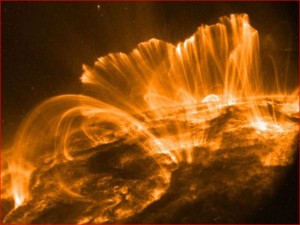Neutral Hydrogen
 The most important Interstellar medium line from the neutral Hydrogen is 21 cm (radio) line. It comes from the hyperfine splitting of the ground state of the Hydrogen atom. Hyperfine structure can be seen because of the coupling (or interaction) between the nuclear and the electronic spins. The energy difference between ortho (higher) and para (lower) state is
The most important Interstellar medium line from the neutral Hydrogen is 21 cm (radio) line. It comes from the hyperfine splitting of the ground state of the Hydrogen atom. Hyperfine structure can be seen because of the coupling (or interaction) between the nuclear and the electronic spins. The energy difference between ortho (higher) and para (lower) state is This energy difference due to the spin flip transition of ortho and para state produces emission of rest frequency,
= 1420.41 MHz and rest wavelength
Hydrogen atom are excited into the upper state through collisions. The oscillator strength of this transition is so small that it takes an average time of for a photon to be emitted from one hydrogen atom. Such a rare transition can only be observed if there is an enormous abundance of neutral hydrogen. It has no dipole moment. Thus, no rotational and vibrational transition. No electronic transition upto 5000 K.
Ionized Hydrogen (HII)
Ionized gases produces ’emission lines’ from electronic transitions. [UV radiation emitted from the young stars ionize and heat up the neutral or molecular hydrogen forming HII region] The strongest hydrogen emission line at 656.3 nm gives HII regions their characteristic red color. This wavelength corresponds to energies > 13.6 eV, the ionization energy from the ground state of hydrogen. HII region are regions of fully or partially ionized hydrogen surrounding very hot young stars of O and B spectral types Hot stars produce UV photons (). These energetic photons photo ionize hydrogen producing a region of HII (ie H+).
PN is like a compact HII region, where population inversion becomes possible. The over populated excited state then decays by stimulated emission i.e. it becomes a maser. When electrons in HII region gyrate relativistically in a magnetic field, a synchrotron radiation can be observed in optical and radio. Supernova remnants have strong emission lines. They mix with low density component of Interstellar medium forming HII region.






